The Operating Week Ahead: November 10, 2025
Your operating briefing on markets, companies, and what matters next
Check out these reader favorites:
The Week That Was
Market Snapshot
Markets found their footing despite a data blackout. The S&P 500 climbed 2.5%, its strongest weekly performance since July, driven by better-than-expected tech earnings and muted inflation concerns, even as the government shutdown prevented release of the October jobs report for the second consecutive month. Investors priced in optimism that the Federal Reserve might deliver one more rate cut in December, though Chair Powell’s increasingly hawkish tone suggests that bet may be premature.
The Big Story: Washington Recalibrates the Rules
Two inflection points dominated the week, both emanating from 1600 Pennsylvania Avenue.
First, the Supreme Court spent nearly three hours grilling the administration on Trump-era tariffs. Justices across the ideological spectrum, from Amy Coney Barrett to Sonia Sotomayor, expressed skepticism about whether the president can invoke emergency powers to unilaterally reshape trade policy. Chief Justice Roberts signaled the court might apply the “major questions” doctrine, which would require explicit congressional authorization for sweeping economic actions. The ruling, expected within weeks, will determine whether supply chain decisions over the next decade are made in the White House or on Capitol Hill.
Second, new Treasury guidance effectively dismantled the 2022 corporate minimum tax, handing billions back to multinationals, private equity firms, and cryptocurrency companies. What was projected to generate $222 billion over a decade will now yield a fraction of that. Combined with July’s $4 trillion tax package, this represents the most significant corporate tax restructuring since the 1980s, and it fundamentally rewrites the earnings math heading into 2026.
For operators, both moves signal the same reality: policy volatility is no longer an edge case. It’s the baseline assumption for planning.
The third quarter delivered a 13.1% blended earnings growth rate across the S&P 500, the fourth consecutive quarter of double-digit expansion, with 82% of reporting companies beating estimates. But beneath the headline strength, a clear pattern emerged: the companies winning are those willing to bet billions on AI infrastructure, consequences be damned.
“In our 25-year data history, this frequency of earnings surprises has been surpassed only during the Covid reopening period in 2020-2021.”
Goldman Sachs on the current US S&P 500 earnings reports
Microsoft posted Q1 FY2026 revenue of $77.8 billion (up 18%), with Azure revenue surging 34% as enterprise adoption of Copilot accelerated. The company spent a record $35 billion on capital expenditures—primarily data centers and AI chips and signaled that pace will continue. Operating income grew 24% to $38 billion, proving that at scale, AI spending can coexist with margin expansion.
Alphabet crossed $100 billion in quarterly revenue for the first time, up 16% year-over-year, silencing critics who predicted ChatGPT would erode Google’s search dominance. Google Cloud revenue jumped 34% to $15.2 billion, while search revenue rose 15%. Net income surged 33% to $35 billion. The company raised 2025 capex guidance to $91-93 billion—a $10 billion increase from prior estimates—to fund AI model training and inference capacity.
Apple delivered record September quarter results: $102.5 billion in revenue (up 8%), with Services crossing $100 billion for the full fiscal year. iPhone revenue came in slightly soft at $49 billion amid supply constraints for the iPhone 17, but Mac revenue surged 13% on the strength of M3-powered devices. The company generated $29.2 billion in operating cash flow, underscoring its ability to fund both massive shareholder returns and R&D without breaking stride.
Meta saw its stock plunge into bear market territory despite strong ad performance, after raising 2025 capital expenditure guidance to $70-72 billion with expectations that 2026 could exceed $103 billion. Investors drew parallels to the metaverse spending spree, wiping out $307 billion in market value over four days. Reality Labs continues losing money, but management argues infrastructure built today will power revenue three years out. The market isn’t buying it—yet.
Amazon beat on all metrics: Q3 revenue of $180.2 billion (up 12%), EPS of $1.95 (25% above consensus), and AWS growth reaccelerating to 20.2%. The company raised full-year capex to $125 billion, with CFO Brian Olsavsky noting that:
“We’re still supply-constrained on AI capacity, not demand-constrained.”
For operators watching enterprise spending, that’s the signal: budgets are following AI workloads, not cutting them.
Palantir crushed expectations with 63% revenue growth to $1.18 billion and U.S. commercial revenue up 121%, a clear sign that enterprise adoption of AI platforms is no longer speculative. Net income more than tripled. But the stock fell 8% on valuation concerns, trading at 81x forward sales. The market’s message: growth is real, but multiples have run ahead of fundamentals.
AMD posted record Q3 revenue of $9.2 billion (up 36%), driven by a 73% surge in Data Center revenue. But shares dropped 9% as investors worried about the Intel-Nvidia partnership and ongoing gaming segment weakness. The selloff underscores a hard truth: in AI infrastructure, being good isn’t enough, you need to be indispensable.
Airbnb delivered its highest quarterly EBITDA ever ($2.1 billion) on revenue of $4.1 billion (up 10%), with nights booked accelerating to 9% growth. The “Reserve Now, Pay Later” feature drove a surge in longer lead-time bookings, suggesting consumers are planning and spending further in advance than expected. For anyone reading travel as a leading indicator of consumer health, that’s encouraging.
Uber set an all-time record with 3.5 billion trips (up 22%), yet the stock fell 5% after Q4 guidance disappointed. Here’s the tension: operational execution is flawless, but the market wanted proof that profitability can scale faster than trips. It’s a reminder that investor expectations reset constantly, meeting them isn’t enough.
Spotify crossed 700 million monthly active users and swung to a €899 million profit, up from a loss a year ago. The company’s bet on cost discipline over growth-at-all-costs is paying off. But ad revenue declined 6%, a warning sign for any platform relying on brand budgets in a tightening economy.
October witnessed the worst month for layoffs in 22 years: 153,074 job cuts, up 183% from September and 175% versus a year ago. Year-to-date cuts now exceed 1.1 million, the highest since the pandemic, and the trend is accelerating.
Amazon announced approximately 14,000 corporate role eliminations, with reports suggesting eventual cuts could reach 30,000. CEO Andy Jassy framed it as “removing layers” to reallocate resources toward AI. Translation: middle management is being algorithmically replaced.
UPS eliminated over 48,000 positions amid volume declines and facility automation. The company is essentially rebuilding its operating model around machines, not people.
Target cut 1,800 corporate roles (8% of HQ headcount) to “accelerate decision-making.” That’s the new language for delayering: speed requires fewer approvals, which requires fewer approvers.
Accenture laid off 11,000 employees it deemed unable to reskill for AI-related work. This isn’t a temporary cost-cutting measure—it’s a permanent reallocation of human capital toward roles machines can’t yet perform.
Starbucks approved a $1 billion restructuring to close hundreds of underperforming stores and eliminate ~900 corporate positions. CEO Brian Niccol’s mandate: return to “coffeehouse and customer,” which apparently requires less square footage and fewer PowerPoint decks.
Boeing’s machinist strike entered its fourth month with no resolution in sight. Workers have rejected four contract offers; Boeing rejected the union’s counteroffer and began hiring permanent replacements. The company is betting it can train new workers faster than the union can hold out. Both sides may be wrong.
Intel reported a return to profitability (Q3 revenue up 3%, EPS of $0.23) after selling its Altera division and additional Mobileye shares. But Intel Foundry posted a $2.3 billion operating loss, and the path to sustainable profitability remains unclear. The company cut R&D spending by 20% year-over-year—a gamble that cost discipline today won’t sacrifice competitiveness tomorrow.
Kimberly-Clark announced it will acquire Kenvue (J&J’s consumer health spinout) for $48.7 billion, creating a $32 billion consumer health powerhouse. The bet: combining Huggies and Tylenol generates more pricing power and distribution leverage than either brand alone. With $2.1 billion in expected synergies, the deal presumes scale still matters in an era of digital-native DTC brands.
The through-line across all these moves: companies are choosing to be smaller, faster, and more automated. The question for operators is whether your own business model can survive that same scrutiny.
Five pieces that shaped my thinking this week:
1. Hybrid Work Is Not the Problem — Poor Leadership Is – MIT Sloan Management Review
Read If: You’re tired of proximity bias masquerading as leadership strategy, or you need ammunition for your next conversation with executives who think butts in seats equals productivity.
The Thesis: Companies failing at hybrid work aren’t victims of the model—they’re victims of poor management. Organizations that excel at flexible work share identical capabilities that have nothing to do with attendance policies: they focus on outcomes over presence, invest in improving how teams collaborate, and recognize that real performance happens at the team level, not in headquarters.
Why It Matters: The return-to-office mandates sweeping corporate America are solving the wrong problem. Leaders blaming hybrid work for productivity issues are actually admitting they never learned to manage for outcomes in the first place. The companies pulling ahead, from Atlassian to GitLab to dozens of others profiled in the research, have discovered that workplace transformation isn’t about where people work, but how they work together to drive results. They’ve built what the authors call “outcome-based management”: clear goals, transparent metrics, team-level autonomy, and ruthless elimination of performative work.
Money Quote: “The organizations excelling at flexible work today share identical capabilities that have nothing to do with specific attendance policies. Instead, they’ve discovered that workplace transformation isn’t about where people work, it’s about how they work together to drive outcomes.”
2. AI’s Hidden Recession: How Fewer Jobs and Cultural Backlash Create a Governance Crisis – Fortune
Read If: You need to defend your AI investments to a board that’s starting to ask harder questions about second-order effects.
The Thesis: AI is reshaping work faster than policy can adapt, creating record productivity alongside stagnant payrolls. Goldman Sachs estimates 300 million full-time jobs globally could be affected. But the deeper risk isn’t unemployment—it’s how societies historically respond when work becomes scarce: they ration opportunity, and women pay the price.
Why It Matters: This isn’t a technology story masquerading as a social one—it’s a governance crisis with balance sheet implications. When “headcount-light” companies scale output without adding workers, they risk compressing the labor force that sustains consumer demand. For boards and operators, the piece argues this is a fiduciary issue, not an HR one: quantify how AI changes your skill mix, pay equity, and legal exposure over five years, or risk insurers and lenders pricing in that uncertainty for you.
Money Quote: “Companies cannot thrive indefinitely in economies that cannot sustain full employment. A short-term efficiency story can quickly become a long-term demand problem.”
3. Is This a Moment for Strategic Hibernation? – Harvard Business Review
Read If: You’re wrestling with whether to double down on a strategic initiative that’s suddenly facing regulatory or cultural headwinds and wondering if there’s a third path between retreat and confrontation.
The Thesis: When political or regulatory headwinds turn hostile, companies have four options: exit the market, speak out publicly, comply quietly, or enter “strategic hibernation”—a deliberate, low-visibility mode where you preserve core capabilities while minimizing exposure, waiting for conditions to shift.
Why It Matters: Most operators default to fighting through volatility or cutting their losses. But some of the most successful long-term plays come from companies that know when to go quiet. Biotech firms during the Bush-era stem cell funding restrictions didn’t abandon research—they moved it offshore, found private funding, and kept teams intact. When Obama lifted restrictions, they were first to market. The lesson: sometimes the smartest move is to build below the radar.
Money Quote: “The goal isn’t to stand still—it’s to build quietly, align deeply, and prepare to reemerge when conditions shift. The firms that will lead in the long run are not those that are loudest in challenging times, but those that navigate with clarity of purpose.”
4. What Every Company Can Learn from Private Equity – Harvard Business Review
Read If: You suspect your company has structural inefficiencies but lack the political capital or analytical framework to address them systematically.
The Thesis: PE-backed companies outperform peers not because they’re ruthless, but because they’re disciplined. The article distills six practices: full-potential due diligence on a recurring basis, precision-matched management teams, “clean-sheet” labor models, ruthless elimination of unprofitable revenue, granular accountability, and treating leadership time as a scarce asset.
Why It Matters: You don’t need a PE sponsor to run a company like one. The value creation playbook isn’t proprietary—it’s just disciplined. Most operators know what needs fixing; PE firms simply have the mandate (and incentive structure) to act without sentimentality. The question is whether you’re willing to apply the same scrutiny to your own business before someone else does it for you.
Money Quote: “PE firms don’t just invest—they transform. The playbook they follow offers a blueprint for transformation that any business could apply.”
5. The Perils of Algorithmic Pricing – MIT Sloan Management Review
Read If: You’re implementing or already using algorithmic pricing and want to avoid becoming a test case for the next wave of antitrust enforcement.
The Thesis: Several recent court cases contend that pricing algorithms used by hotels and multifamily landlords pose antitrust risks. Federal regulators argue these systems can lead to unintended collusion and antitrust violations, even without explicit agreements. The research shows that algorithms relying on centralized decision-making and private competitor data create the highest risk of collusive outcomes.
Why It Matters: If you’re using dynamic pricing—and increasingly, everyone is—you need to understand the legal exposure. The article provides a framework: algorithms that use only public data and decentralized decision-making are defensible; those that share private pricing data across competitors or rely on centralized optimization are walking into an enforcement minefield. The DOJ has already brought cases against RealPage (multifamily housing) and multiple hotel chains. The lesson: your pricing algorithm’s architecture matters as much as its output.
Money Quote: “Businesses can reduce the risk of collusion with algorithms that rely on decentralized — as opposed to centralized — decision-making and use only public, not private, data.”
Here’s what to watch:
The Week in One Sentence
Thursday’s CPI report will determine whether the Fed cuts in December and whether your 2026 budget assumptions around cost of capital still hold.
Operating by John Brewton goes deep on what it takes to build, scale, and optimize modern companies. This breakdown analysis is just the starting point. Check out last week’s analysis of Amazon’s current operating strategy to see more.
What Paid Subscribers Get:
📬 3x Weekly Operating Notes – Short, actionable insights on corporate strategy, operating excellence, and business history
📊 Epic Operating Resource Articles – Deep-dive case studies and frameworks (like the Carnegie, Sloan, and Grove comparisons) available exclusively to paid members
💬 Paid Subs-Only Chat & Operating Working Group – Direct access to John and a community of operators tackling real challenges
🎙️ Quarterly Live Operating Q&A – Community working sessions where we break down current strategies and answer your questions
Operating Founders get even more:
🤝 Quarterly 1:1 Operating Sessions with John – Four 30-minute private sessions per year to work through your specific operating challenges
Plans
Monthly: $17/month
Annual: $95/year (save 54%)
Operating Founder: $550/year (includes 1:1 sessions)
Most importantly, thank you for reading! I’d love for you to join our growing community and help you solve your biggest operating conundrums in any way I can.
The Operator’s Edge
The gap between Meta’s AI spending and its AI revenue might seem irrelevant to your immediate circumstances, but I think that’s precisely why you should be asking harder questions about your own technology investments.
“Everyone else is doing it…” is never a sound answer.
The companies that will win through the next 18 months are those that can articulate exactly how those dollars translate into margin expansion, customer retention, or competitive moats. The rest are just burning capital and hoping something works.
This week, inflation data will tell us whether the macro tailwinds persist. But the micro question, whether your business model can survive the same scrutiny Amazon, Starbucks, and Intel are applying to theirs, is entirely within your control.
Stay sharp,
- john -
Featured Articles
Hybrid Work Is Not the Problem — Poor Leadership Is – MIT Sloan Management Review, November 2, 2025
AI’s Hidden Recession: How Fewer Jobs and Cultural Backlash Create a Governance Crisis – Fortune, November 8, 2025
Is This a Moment for Strategic Hibernation? – Harvard Business Review
What Every Company Can Learn from Private Equity – Harvard Business Review, November-December 2025 Issue
The Perils of Algorithmic Pricing – MIT Sloan Management Review, November 3, 2025
Market & Economic Data Sources
Federal Reserve Interest Rate Decision – Federal Reserve, October 29, 2025
S&P 500 Earnings Season Update – FactSet, November 7, 2025
U.S. Layoffs Hit 22-Year High – Challenger, Gray & Christmas, November 5, 2025
Company Earnings & News
Microsoft Q1 FY2026 Earnings – Microsoft Investor Relations
Alphabet Q3 2025 Earnings – Alphabet Investor Relations, October 29, 2025
Apple Q4 FY2025 Earnings – Apple Investor Relations, October 30, 2025
Meta Q3 2025 Earnings – Meta Investor Relations
Amazon Q3 2025 Earnings – Amazon Investor Relations, October 30, 2025
Palantir Q3 2025 Earnings – Palantir Technologies, November 3, 2025
AMD Q3 2025 Earnings – AMD Investor Relations, November 4, 2025
Airbnb Q3 2025 Earnings – Airbnb Newsroom, November 5, 2025
Uber Q3 2025 Earnings – Uber Investor Relations, November 4, 2025
Spotify Q3 2025 Earnings – Spotify Newsroom, November 3, 2025
Kimberly-Clark to Acquire Kenvue – CBS News, November 3, 2025
Starbucks Restructuring Plan – Reuters, September 25, 2025
Boeing Machinists Strike – St. Louis Public Radio, November 5, 2025
Intel Q3 2025 Earnings – Intel Corporation, October 22, 2025
Policy & Legal News
Supreme Court Arguments on Trump Tariffs – NPR, November 5, 2025
Trump Administration Tax Changes – The New York Times, November 8, 2025
Economic Calendar & Week Ahead
Economic Calendar Week of November 10-15 – Kiplinger, November 6, 2025
Week Ahead Economic Preview – S&P Global, November 6, 2025
Federal Reserve Calendar – Federal Reserve Board
If you’d like to work together, I’ve carved out some time to work 1:1 each month with a few top-notch Founders and Operators. You can find the details here.
John Brewton documents the history and future of operating companies at Operating by John Brewton. He is a graduate of Harvard University and began his career as a Phd. student in economics at the University of Chicago. After selling his family’s B2B industrial distribution company in 2021, he has been helping business owners, founders and investors optimize their operations ever since. He is the founder of 6A East Partners, a research and advisory firm asking the question: What is the future of companies? He still cringes at his early LinkedIn posts and loves making content each and everyday, despite the protestations of his beloved wife, Fabiola, at times.






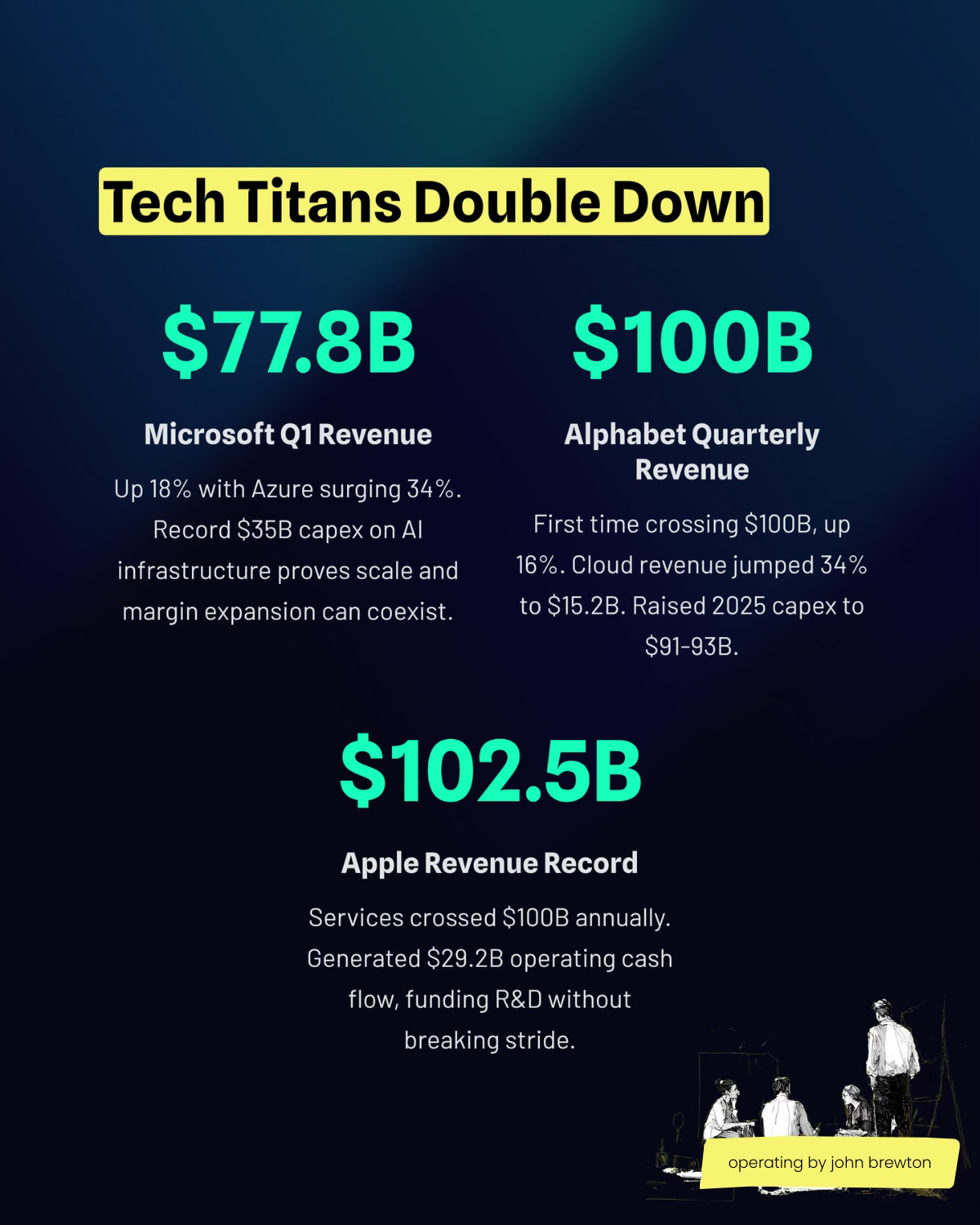
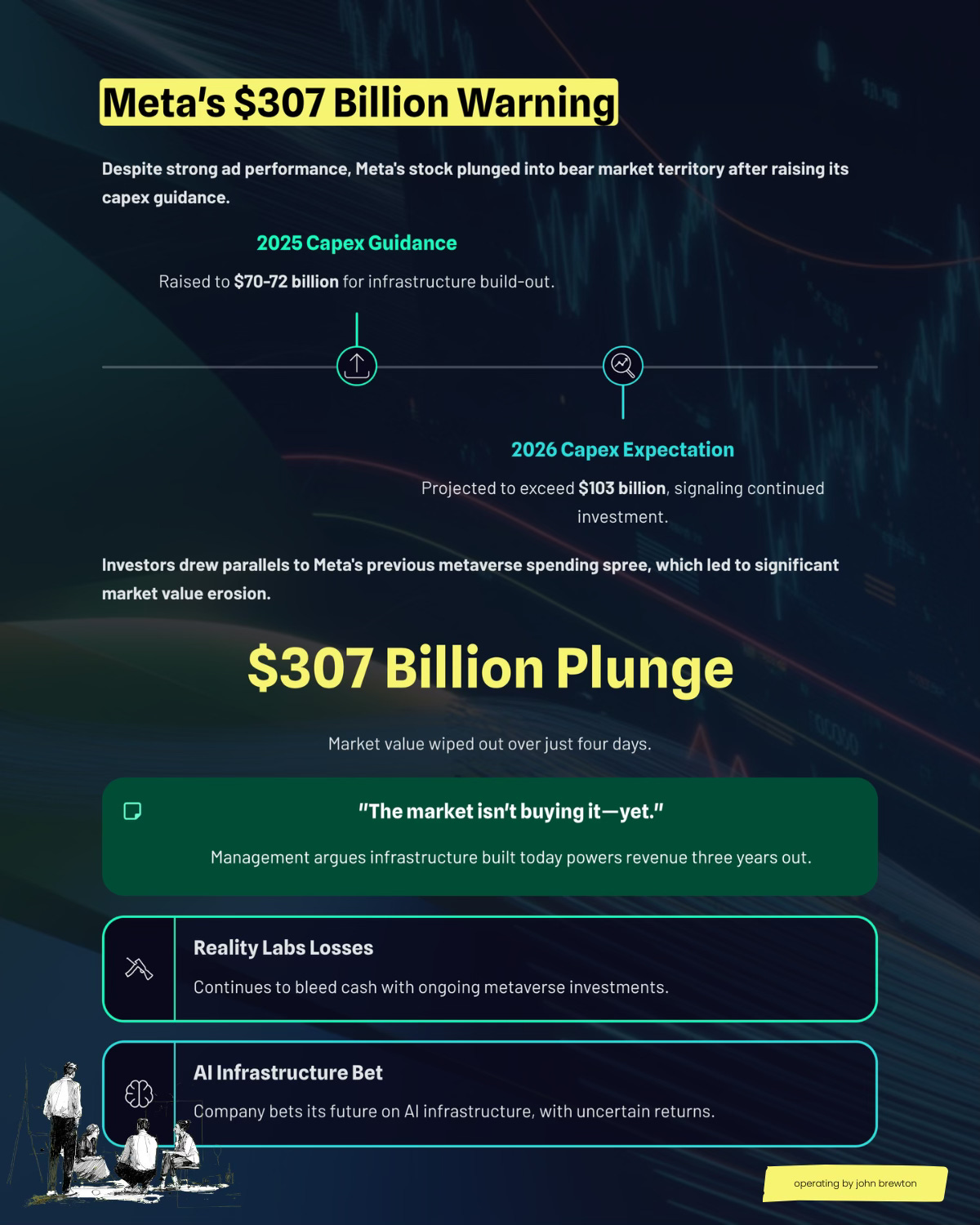
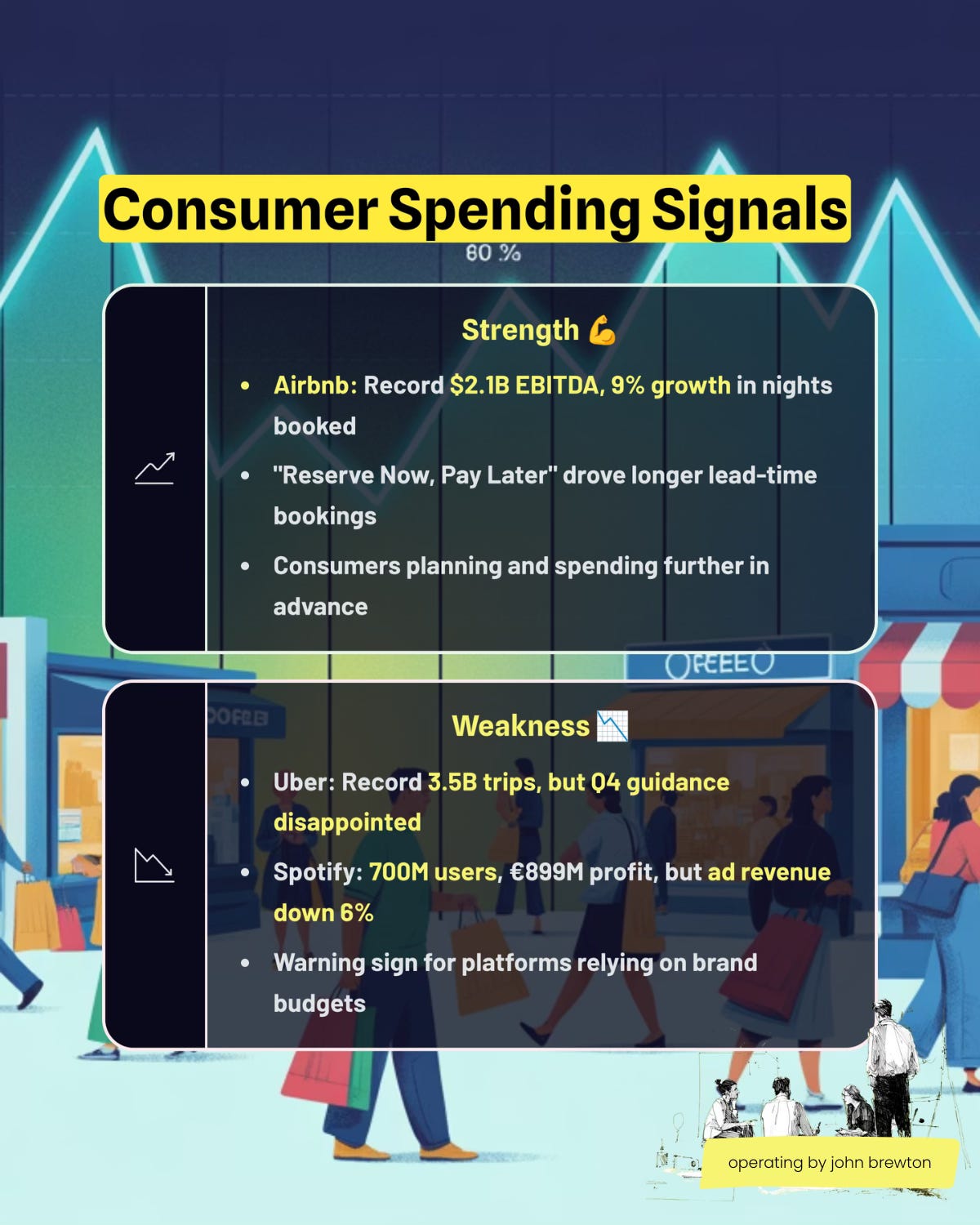





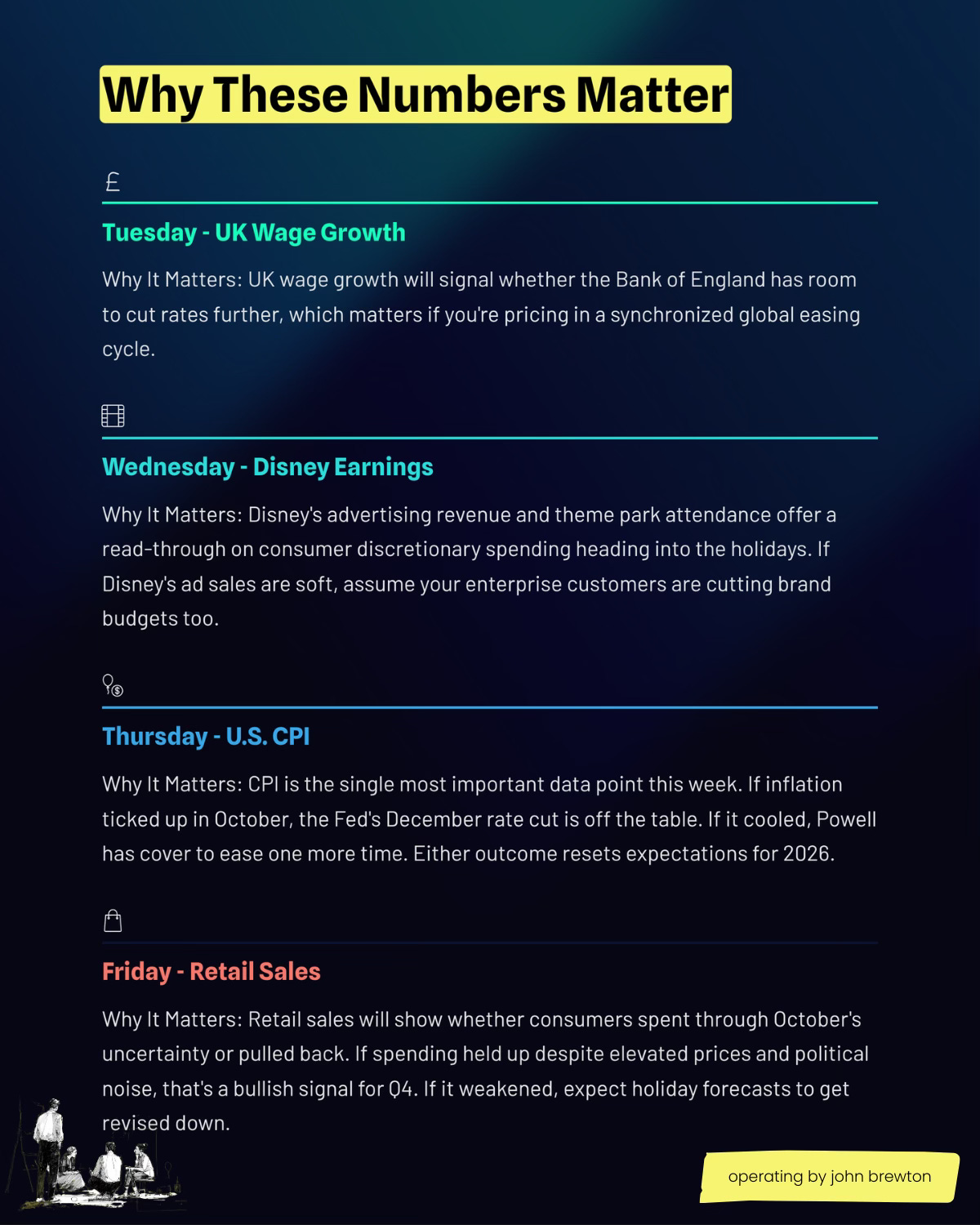



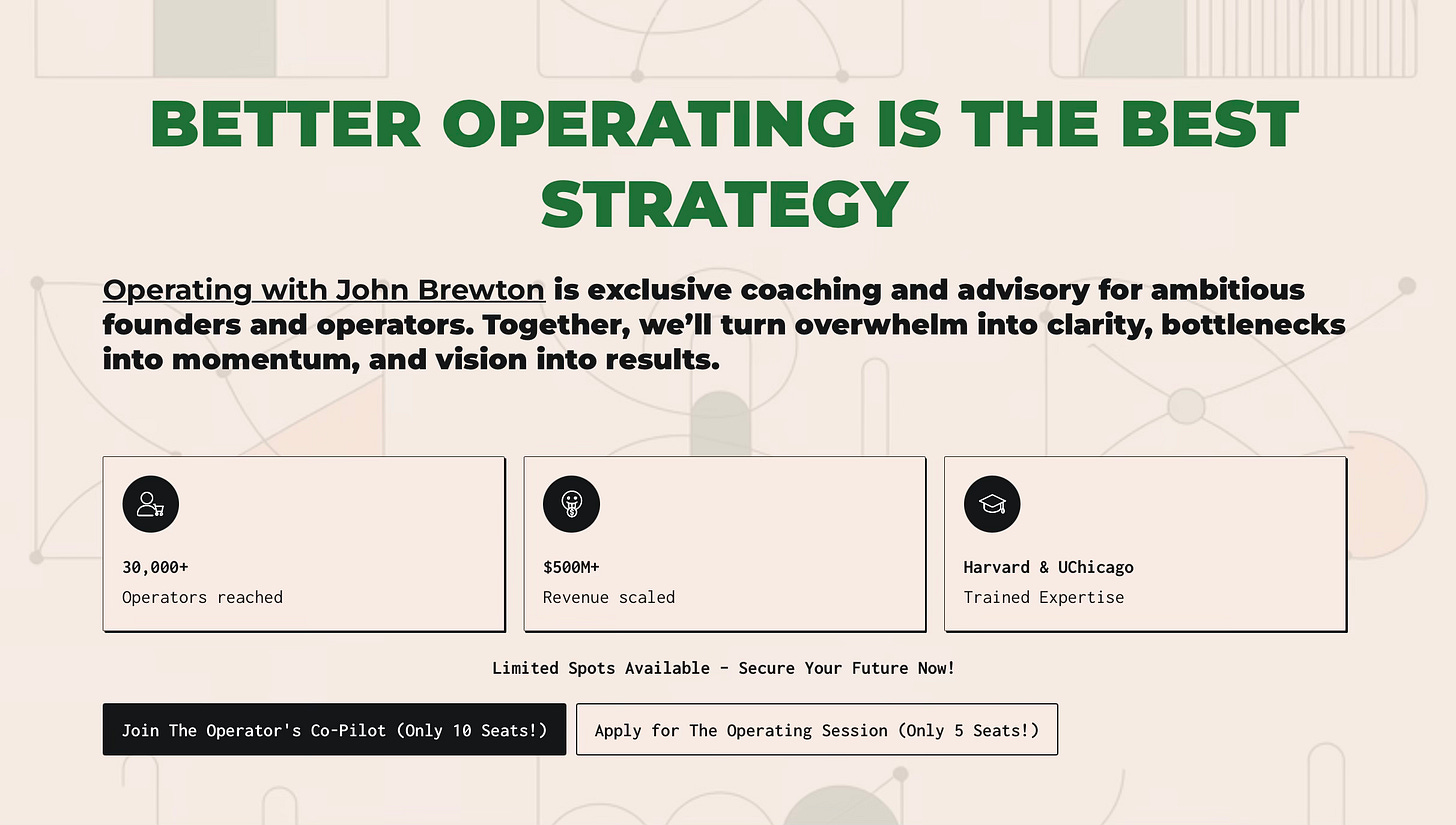

If Treasury has dismantled the 2022 Corporate Minimum Tax and tariffs are in jeopardy, it begs the question of how the U.S. government will continue to fund itself. Thoughts, John?
Essential reading for operators planning 2026 and beyond.